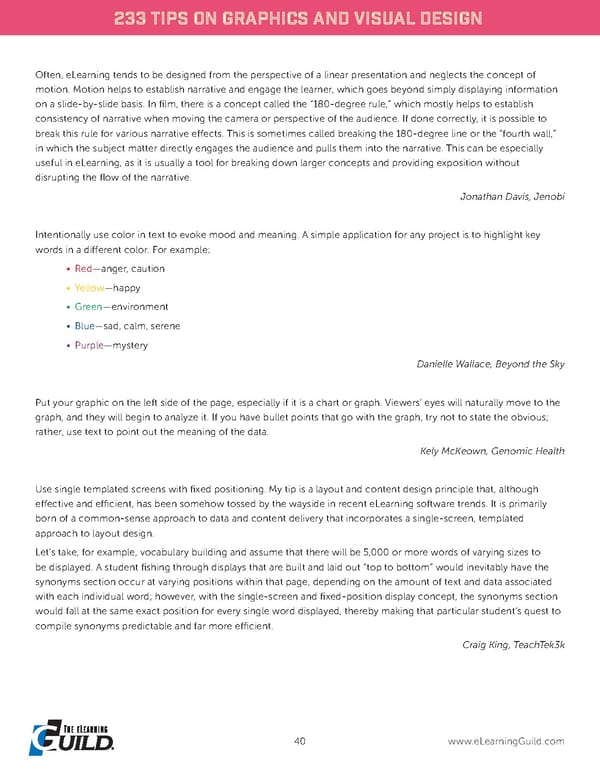233 TIPS ON GRAPHICS AND VISUAL DESIGN Often, eLearning tends to be designed from the perspective of a linear presentation and neglects the concept of motion. Motion helps to establish narrative and engage the learner, which goes beyond simply displaying information on a slide-by-slide basis. In film, there is a concept called the “180-degree rule,” which mostly helps to establish consistency of narrative when moving the camera or perspective of the audience. If done correctly, it is possible to break this rule for various narrative effects. This is sometimes called breaking the 180-degree line or the “fourth wall,” in which the subject matter directly engages the audience and pulls them into the narrative. This can be especially useful in eLearning, as it is usually a tool for breaking down larger concepts and providing exposition without disrupting the flow of the narrative. Jonathan Davis, Jenobi Intentionally use color in text to evoke mood and meaning. A simple application for any project is to highlight key words in a different color. For example: • Red—anger, caution • Yellow—happy • Green—environment • Blue—sad, calm, serene • Purple—mystery Danielle Wallace, Beyond the Sky Put your graphic on the left side of the page, especially if it is a chart or graph. Viewers’ eyes will naturally move to the graph, and they will begin to analyze it. If you have bullet points that go with the graph, try not to state the obvious; rather, use text to point out the meaning of the data. Kely McKeown, Genomic Health Use single templated screens with fixed positioning. My tip is a layout and content design principle that, although effective and efficient, has been somehow tossed by the wayside in recent eLearning software trends. It is primarily born of a common-sense approach to data and content delivery that incorporates a single-screen, templated approach to layout design. Let’s take, for example, vocabulary building and assume that there will be 5,000 or more words of varying sizes to be displayed. A student fishing through displays that are built and laid out “top to bottom” would inevitably have the synonyms section occur at varying positions within that page, depending on the amount of text and data associated with each individual word; however, with the single-screen and fixed-position display concept, the synonyms section would fall at the same exact position for every single word displayed, thereby making that particular student’s quest to compile synonyms predictable and far more efficient. Craig King, TeachTek3k 40 www.eLearningGuild.com
 233 Tips on Graphics and Visual Design Page 42 Page 44
233 Tips on Graphics and Visual Design Page 42 Page 44